#the education of william bowman
Explore tagged Tumblr posts
Text
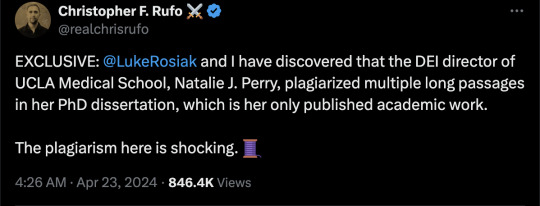




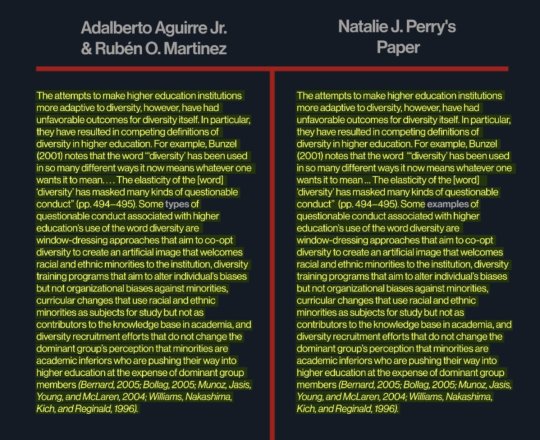

By: Christopher F. Rufo and Luke Rosiak
Published: Apr 22, 2024
Recent headlines about UCLA School of Medicine suggest that the institution has lost its focus. Instead of brushing up on organic chemistry, its students were subjected to lessons on “Indigenous womxn” and “two-spirits.” Future doctors had to take a class on “structural racism” and were led in a “Free Palestine” chant by a Hamas-praising guest speaker. The school made plans to segregate students by race for courses on left-wing ideology, and two of its psychiatry residents championed “revolutionary suicide.”
Why has the school charted this course? One reason is its commitment to diversity, equity, and inclusion ideology. UCLA has a DEI program called “Cultural North Star,” and at the medical school, it is led by Natalie J. Perry, whose official title is Cultural North Star Lead. Her UCLA biography says that her job is to “embed our aspirational Cultural North Stars [sic] value [sic] in our organizational DNA.” UCLA honored Perry last month for teaching students to “do what’s right,” saying her “empathy and radical listening” are to thank for her “success as an educator and a leader.”
According to a Daily Wire and City Journal investigation, however, Perry’s academic career is based on fraud. Perry published her Ph.D. dissertation in 2014 at the University of Virginia about college diversity programs. An analysis of the paper found it ridden with the worst sort of plagiarism, reproducing large swaths of text directly from several other authors, without proper citations. The scale of the plagiarism suggests that Perry lacks both ethics and competence and raises questions about academic programs that push DEI.
Perry’s dissertation lifted passages from ten other papers. In key portions of her text, she copied almost every paragraph from other sources without attribution. She fails even to mention at least four of the ten plagiarized papers anywhere in her dissertation.
Let’s review some examples.
The first three pages of Perry’s paper, “Faculty Perceptions of Diversity at a Highly Selective Research-Intensive University,” suggest that she did not even bother to read beyond the first page of papers from which she stole. Her dissertation’s second sentence reproduces verbatim part of a sentence on the first page of a paper by Adrianna Kezar, Peter Eckel, Melissa Contreras-McGavin, and Stephen John Quaye. Her third paragraph, without citation, lifts more than 100 words from the first page of a paper by Angela Locks, Sylvia Hurtado, Nicholas Bowman, and Leticia Oseguera.
Each colored portion of the below text was taken from a different author:
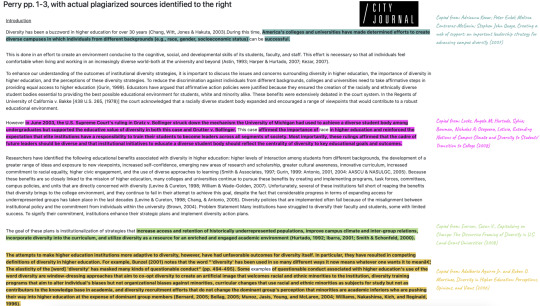

In some cases when Perry did include parenthetical citations, she wasn’t citing the papers whose text she had lifted. Instead, she simply reproduced the citations included in those stolen excerpts.
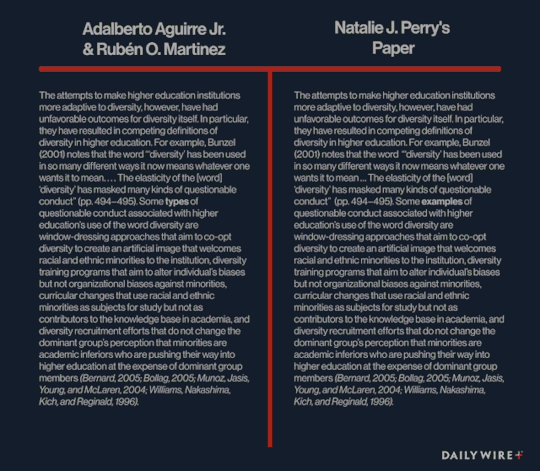
Take the above paragraph, which ends with “(Bernard, 2005; Bollag, 2005; Munoz, Jasis, Young, and McLaren, 2004; Williams, Nakashima, Kich, and Reginald, 1996).” Perry was not synthesizing those authors. Instead, the citation was part of Adalberto Aguirre and Ruben Martinez’s paper, from which she apparently copied and pasted, without attribution.
A core part of Perry’s dissertation involved summarizing work done by professors Robert Quinn and John Rohrbaugh. Instead of citing them directly, however, Perry cribbed summaries from other academics. Perry copied and pasted almost all of a nearly thousand-word passage from a paper by Chad Hartnell, Amy Yi Ou, and Angelo Kinicki, without quoting the authors.
Consider, for example, the following excerpt from Perry’s dissertation. The italicized portions were taken verbatim from Hartnell, Yi Ou, and Kinicki’s paper:
The CVF is widely used in organizational literature (Ostroff et al., 2003). Measures of organizational culture that directly or indirectly assess the CVF have been administered in over 10,000 organizations globally (Cameron et al., 2006) within the following academic disciplines: management, marketing, supply-chain management, accounting, social services, hospitality, and health care. Further, the reliability and content validity of Cameron and Ettington's (1988) measure of the CVF has been empirically supported in studies utilizing multitrait-multimethod analysis (Quinn & Spreitzer, 1991), multidimensional scaling (Howard, 1998), and structural equation modeling (Kalliath, Bluedorn, & Gillespie, 1999). Surprisingly, prior to 2011, there had been limited assessment of the theoretical foundation of the CVF despite its reported content validity and widespread use in research and practice.
The rest of Perry’s analysis of Quinn and Rohrbaugh’s work is largely copied, unquoted and unattributed, from a 2003 paper by John Smart. Below are pages 13 and 14 of Perry’s paper, outlining its “Theoretical Framework,” with the italicized text coming directly from Smart:
To develop this theory Quinn and Rohrbaugh (1983) asked a panel of distinguished organizational theorists to evaluate the similarity between every possible pair of 39 indexes of organizational effectiveness derived from Campbell’s (1977) exhaustive synthesis of criteria used to assess the performance of organizations. The results of this analysis revealed three basic dimensions underlying the judgments of respondents. The first dimension is organizational focus, which distinguishes organizations that have an internal emphasis on the development of people from those that have an external focus on the development of the organization. The second dimension is organizational structure, which distinguishes between organizations that have an emphasis on stability and control from those that have an emphasis on flexibility and innovation. The third dimension is organizational means and ends, which distinguish between organizations that emphasize processes such as planning and establishing goals from those that emphasize resulting outcomes such as productivity and efficiency.
In a section titled “Positioning Diversity Leadership in Higher Education,” Perry copies almost every sentence from one of several other papers. In no case does she credit the actual source:
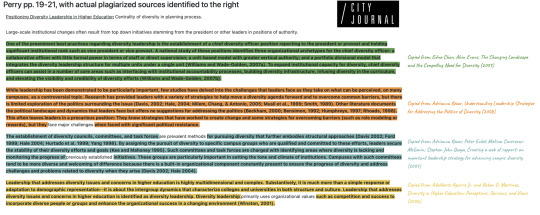
Finally, in a section on organizational culture, Perry duplicates language from a variety of other authors:
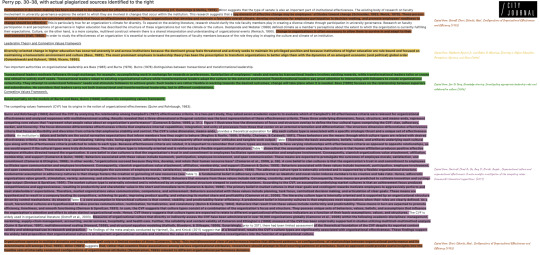
Perry presented her paper as “qualitative” research because she chatted with what appear to be ten members of her colleagues at the University of Virginia who sat on the faculty-retention taskforce and counted their musings as “data.” But when the paper gets to this section, where plagiarism wasn’t possible, Perry includes the following jumbled passage that includes a glaring spelling error:
The positionality of the participants informed the perspective on the origins of the commission. /in response to the needs of the varios [sic] stakeholders within the university, the commission addressed issues of diversity on the faculty, undergraduate, graduate, and university level.
The section of original text suggests that her plagiarism could be used to mask glaring academic deficiencies. Moreover, Perry in her references section fails to list some of the papers that she cites parenthetically in the body of the dissertation—a telltale sign that she had simply copied those citations from somewhere else. Legitimate academic inquiry would not excuse such shoddy work.
Perry and UCLA did not return requests for comment.
Entrepreneur Mark Cuban recently argued that DEI policies don’t necessarily lower an organization’s expectations. But for Harvard, UVA, and UCLA Medical School—where Perry earned her master’s, Ph.D., and DEI position, respectively—this is evidently not the case. These institutions have dramatically lowered expectations for favored groups and pushed a cohort of “scholars” through the system without enforcing basic standards of academic integrity.
Ultimately, Natalie Perry is to blame for her misconduct. But these institutions of higher learning share some fault for permitting such shoddiness to stand unchallenged.
==
These are the same people who want to lecture us how much more morally enlightened they are than we are.
#Christopher Rufo#Christopher F. Rufo#Luke Rosiak#Natalie Perry#academic corruption#plagiarism#academic fraud#diversity equit#diversity equity and inclusion#DEI must die#DEI#diversity#equity#inclusion#diversity hire#DEI bureaucracy#religion is a me#religion is a mental illness
10 notes
·
View notes
Text

Paul Laurence Dunbar High School is a public school located in DC. The school was America’s first public high school for African Americans.
As all public school teachers were federal civil servants, the school’s teachers received pay equal to white teachers. It attracted high-quality faculty, many with advanced degrees, including doctorates. Parents sent their children to the school from across the city because of its high standards. Many of its alumni graduated from top-quality colleges and universities and gained professional degrees.
The school was founded in 1870 as the Preparatory High School for Colored Youth. Ιt became known as M Street High School (1891-1916). When its location was changed from M Street, the school was renamed (1916) for the noted African-American poet, Paul Laurence Dunbar.
Dunbar was designated as an academic high school, with other schools providing more vocational or technical training. Dunbar was known for its excellent academics, some African Americans moved to DC so their children could attend it. The school boasted many graduates who went on to higher education and a generally successful student body.
The school has graduated many well-known figures of the 20th century, including Sterling Brown, H. Naylor Fitzhugh, Nannie Helen Burroughs, Charles R. Drew, William H. Hastie, Charles Hamilton Houston, Robert Heberton Terrell, Benjamin O. Davis Jr., Paul Capel, III, Robert C. Weaver, and James E. Bowman. Its faculty included Anna Julia Cooper, Kelly Miller, Mary Church Terrell, A. A. Birch Jr., Carter G. Woodson, and Julia Evangeline Brooks, who was a graduate of the school. Among its principals were Anna J. Cooper, Richard Greener, Mary Jane Patterson, and Robert Heberton Terrell. An unusual number of teachers and principals held Ph.D. degrees, including historian Carter G. Woodson, the second African American to earn a Ph.D. from Harvard.
Until 1954, Fairfax County, Virginia, had no secondary schools for African Americans. Dunbar and several other District of Columbia public schools accepted African Americans from the county before that time. #africanhistory365 #africanexcellence
0 notes
Photo



CAL BOWMAN and JACKSON MARCHETTI in Sex Education, Season 3
#sex education#sexeducationedit#sexeducationsource#cal bowman#calbowmanedit#Dua Saleh#duasalehedit#jackson marchetti#Jackson Theodore Marchetti#qpocdailyedit#bbelcher#chewieblog#tvedit#cinematv#lgbtedit#lgbtsource#dailytvfilmgifs#dailylgbtq#Kedar Williams-Stirling#kedar williams stirling#savi
454 notes
·
View notes
Text




the black representation in sex education>>
#sex education#sex education season 3#dua saleh#ncuti gatwa#eric effiong#kedar williams stirling#Jackson marchetti#chinenye ezeudu#Vic odesanya#cal bowman
523 notes
·
View notes
Text

This underrated trio’s characters are amazing. I wanna see more POC characters like them!!
#sex ed#sex education season 3#sex ed netflix#sex education spoilers#sex education s3#sex education#sex ed season 3#jackson marchetti#keddar williams stirling#cal bowman#dua saleh#viv sex education#viv odusanya#chinenye ezeudu#black characters#poc artist#friendship goals
333 notes
·
View notes
Text
An American Dream: the Education of William Bowman (2016)

I’m almost certain that no one reading this will have heard of An American Dream: the Education of William Bowman, but if I can deter even one person from seeing this film, I’ll be happy. It’s one of the most maddening, pretentious, scramble-brained plot salad movies I’ve ever seen.
When high-school football player William (Jake Croker) receives a concussion during practice, he has a vision of what the world has to offer him. What he sees is a terrifying America, a place full of gun nuts, religious hypocrites, fear-mongering cabals, sex-obsessed beautiful women, reality-TV-loving degenerates and dubious morals.
This is what I like to call an “And Then” story. “… and then, since William doesn’t have a job anymore, he becomes homeless. And then, a girl who hosts this reality-TV show where she picks up homeless guys has sex with him. And then, he gets mugged so he loses all his money again. And then ….” You get the idea. The plot bounces from one thinly-veiled criticism about America to the next. It doesn’t matter if they follow each other logically, if the satire is poignant or well done, it just keeps going. On and on, in a tale that’s as shallow as a puddle and as subtle as an atomic bomb.
Writer/Director Ken Finkleman is Canadian and he’s made a film entirely set in America (actually shot in Ontario), about American people, criticizing virtually every aspect of America life. I don’t think you can do that, not without proving that you have your head so far up your rear end that it snakes up your digestive system infinitely. You really have to think you’re the king of all intellectuals to criticize a country you don’t even live in the way this film does. If at least the satire was smart, but it isn’t. You’ve figured out everything this film has to say 15 minutes in. The only thing that prevents you from being bored is that the plot is absolutely insane.
There’s no way you can predict what An American Dream has in stores next, except when it’s so obvious you can’t believe the idiotic protagonist hasn’t figured it out yet. We’re talking about Branded or Southland Tales-level insanity. I could summarize entire scenes but you’d never believe that what I’m putting down isn’t a complete fabrication.
I’m not going to give this film the lowest score possible. It’s not that this disaster, which I saw in a deserted theater, has anything redeeming, it’s that I REALLY don’t want you to see it. If I tell you it’s a 0-star movie, you’ll be curious. I don’t want you to see An American Dream: the Education of William Bowman. (Theatrical version on the big screen, April 27, 2017)
#an american dream: the education of william bowman#an american dream: the education of william bowman movie review#the education of william bowman#an american dream#william bowman#movies#films#movie reviews#film reviews#reviews#ken finkleman#diana bentley#shiloh blondel#jan caruana#precious chong#jake croker#2016 movies#2016 films#branded#southland tales#adamwatchesmovies
1 note
·
View note
Photo
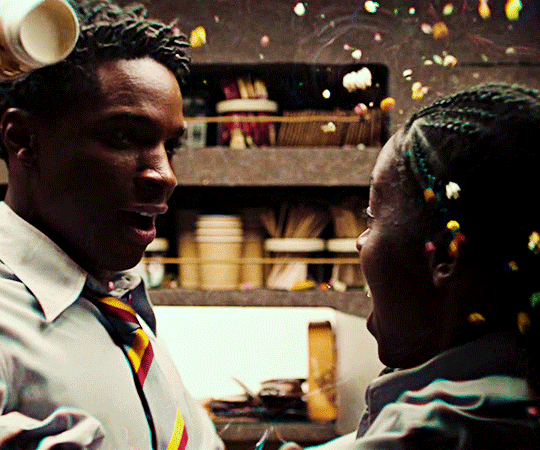


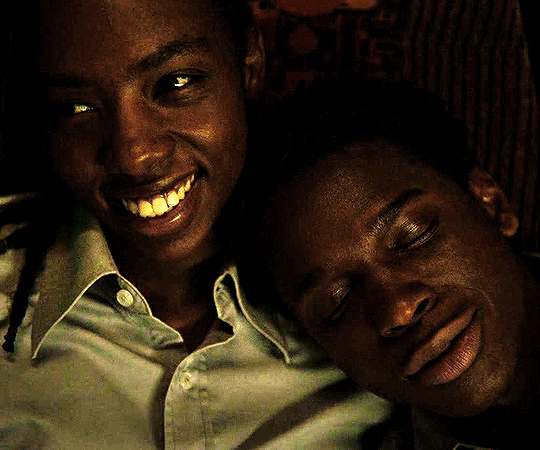

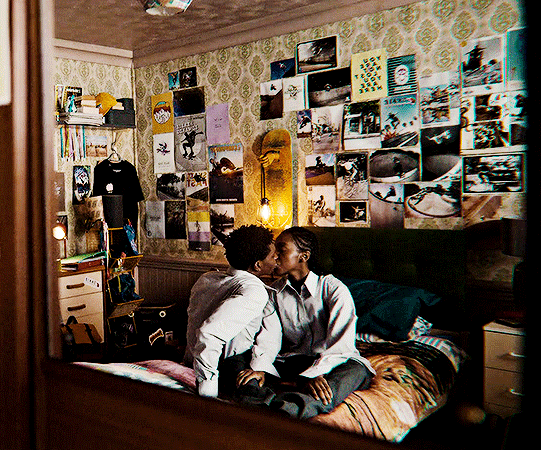
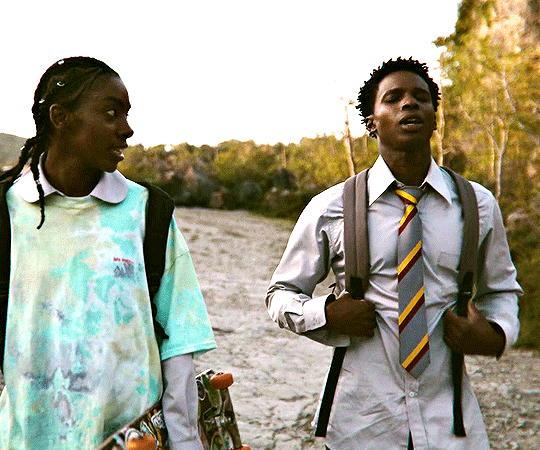
This is the first time I've felt calm in so long. Yeah. It's quite nice, right?
Dua Saleh and Kedar Williams-Stirling as Cal Bowman and Jackson Marchetti in Sex Education Season Three
#sex education#sexeducationedit#sex education spoilers#bbelcher#userstream#filmtv#cinemapix#dailynetflix#dailymoordale#userbru#userbecca#userava#userrachel#tuserchar#tuserdiana#cal bowman#jackson marchetti#cal x jackson#*#mine
3K notes
·
View notes
Text
The FBI on Thursday raided three churches associated with the House of Prayer Christian Church in Georgia and Texas.
The FBI has not released a statement regarding the raids.
The House of Prayer is owned by the foreign nonprofit company House of Prayer Christian Churches of America Inc., which registered with the Georgia Secretary of State in 2004. The business's listed officers are affiliated with the Georgia churches and use Hinesville, Georgia, post office boxes as mailing addresses.
Its churches, which are primarily located near military bases throughout the country, have been accused by former members and a veterans' advocacy group of operating like a cult and targeting soldiers.
In August 2020, Veterans Education Success, an advocacy organization based in Washington D.C., asked the U.S. Department of Veterans Affairs and the Georgia Veterans Service to investigate alleged abuses of the GI Bill program by House of Prayer Christian Church’s bible seminaries.
Veterans alleged the House of Prayer Christian Church "deceives the VA during inspections and targets veterans in order to access GI Bill funding, VA disability compensation, and VA home loans," according to the organization's letter to the VA and Georgia SAA.
Raid near Fort Stewart
The FBI on Thursday raided The House of Prayer Christian Church in Hinesville. The raid took place just after 8 a.m. on the 2500 block of Airport Road.
Onlookers observed FBI agents with weapons traveling to multiple buildings while a group of women were being guarded by an officer with a weapon.
Jenna Sellitto, an FBI spokesperson, confirmed the agency was executing a court-authorized search warrant. She said no arrests had been made as of Thursday afternoon.
The House of Prayer Christian Church in Hinesville is located less than 8 miles from Fort Stewart in Liberty County.
Raid near Fort Gordon
Half a dozen FBI agents were seen in the back of the Assembly of Prayer church on Tobacco Road in Hephzibah during a raid that started at about 7:15 a.m. Thursday and continued into the afternoon.
According to a search of property records, House of Prayer Christian Churches owns 2952 Old Tobacco Road, the address of the Assembly of Prayer church in Richmond County.
At about 1 p.m., agents were seen using stairs at the back of the building during the investigation, according to Sgt. William McCarty with the Richmond County Sheriff's Office.
"We were there to assist them, but referring everything over to the FBI," said McCarty. He said he could not confirm if there were any arrests.
The Assembly of Prayer church in Hephzibah is located just outside of Gate 5 at Fort Gordon.
In an email sent Thursday, Anne H. Bowman, deputy public affairs officer at Fort Gordon, said "Fort Gordon was aware of the organization called the Assembly of Prayer Church through our law enforcement channels but the installation had no bans against the organization or any official dealings with them (despite their websites claims)."
Bowman confirmed "there were reports made to Fort Gordon law enforcement of recruiting/solicitation attempts by the church members but there were no incidents, confrontations, arrests or anything of this nature as a result," she said in another email Thursday night.
Raid near Fort Hood
The Assembly of Prayer Christian Church on Massey Street in Killeen, Texas, was also raided by the FBI on Thursday, according to the Killeen Police Department.
The church is located less than 4 miles from Fort Hood.
Killeen officers arrived to assist the FBI with traffic diversion just after 7:30 a.m., according to officials.
Ashley Demorest, a former member of the church who observed the raid, said she was a member of the church from age 15 to 23, "until I finally escaped."
Amber Fitz-Randolph, leader of The Ft. Hood Fallen Facebook page, which was started in 2017, said members of the church in Killeen have snuck into the barracks and threatened soldiers.
In a text message Thursday afternoon, Christopher Haug, chief of media relations at Fort Hood, said they are aware the FBI is investigating the church and their police are looking into it.
Demorest said she solicited soldiers on base as a member of the church.
"When I was 16 I would go with other members to [Fort Hood] and do what the church would call 'soul winning' to invite people to the church," she said.
In the Veteran's Education Success's letter to the VA and Georgia SAA in 2020, the organization cited similar solicitations.
"Soul-winning is an organized event coordinated by HOPCC’s clergy," noted the document. "Five days a week, individuals are paired up and sent out to recruit new members on or around military bases. ... Students would recruit at Post Exchanges, barracks, and on-base housing."
The document also cites specific members' experiences recruiting on bases in Georgia.
11 notes
·
View notes
Text
British teen dramedy Sex Education Season 3, created by Laurie Nunn, wrestles with personal growth and society’s need to de-individualize people. Season 3 begins with young conservative Hope Haddon (Jemima Kirke) taking over as headmistress of Moordale Secondary School.
Spoilers Below
Hope tries to rehabilitate Moordale Secondary School’s reputation as the “Sex School” by creating an authoritarian environment that leaves no room for individuality or creativity. Communication plays a vital role in a lot of characters’ personal growth and the mending of relationships. Unfortunately, the Sex Education writers left the headmistress as a one-note villain.
Sex Education Season 3’s weakest link
Sex Education Season 3’s weakest link is that the depiction of Headmistress Hope Haddon feels one-dimensional. Hope is villainous because she forces students to wear uniforms to stop the queer students from dressing flamboyantly.
She constantly punishes one of the few non-gender binary students, American Cal Bowman (Dua Saleh), and teaches fear-mongering abstinence sex education. She fires head boy Jack Marchetti (Kedar Williams-Stirling) for advocating for Cal and protecting the vulgar historic wall of penises. We never fully understand why Hope is so backward beyond wanting to clean up the school’s image.
Hope comes off as a caricature of a bullying principal. The writers try to humanize her through her infertility problems, but it is not enough. We have no sense of her life outside of school. The headmistress’ veneer of hipness because of her youth doesn’t make a whole personality.
The first headmaster was also strict and unyielding. Michael Groff’s (Alistair Petrie) three-dimensionality came from learning that he cared too much about his reputation. He rode his disruptive son Adam (Connor Swindells) hard. We got to see Headmaster’s Groff homelife making him feel like a human being rather than just a caricature.
A Symbol of Censorship
Headmistress Haddon turns Moordale Secondary School into a symbol of censorship, society fitting everybody into a box, and penalizing rebel artists. For instance, the new school uniforms are a perfect example of how the new Moordale headmistresses have disdain for uniqueness or queerness.
Haddon decides to require school uniforms because the popular Gay student Anwar Bakshi (Chaneil Kular) wears a bright red pimp hat, an unbuttoned black leather jacket with flames, no shirt, black straps, and leather pants. The headmistress unconscious homophobia shines through.
She equates queerness with overt sexuality. Haddon harasses Cal for wearing a loose-fitting boy’s school uniform because they were assigned female at birth. She refuses to respect that Cal doesn’t feel comfortable wearing even one piece of women’s clothing or anything tight because it displays parts of their body they don’t like.
Hope exposes her homophobia by not allowing pansexual Ola Nyman (Patricia Allison) to wear an LGBTQA plus rainbow pin. Students are only allowed to wear school pins. She takes school uniformity to the extreme. Haddon even controls everybody’s hairstyles or makeup.
Maeve Wiley (Emma Mackey) can���t dye her hair blue. Lily Iglehart’s (Tanya Reynolds) Princess Leia-style hairstyle and bright makeup is a no-go at Moordale. Haddon hates that Lily writes alien erotica and refuses to sanitize herself in public. Therefore, she forces Lily, Cal, and Adam to wear whiteboard signs around their necks with an individualized embarrassing message at school. Moordale Secondary becomes a dystopian space under Hope Haddon’s leadership.
Michael’s Character Transformation in Sex Education Season 3
Michael goes through the most significant character transformation in Sex Education Season 3 because he sheds himself of society’s expectations for men. At the start of the season, the ex-headmaster lives with his older brother, macho Peter Groff (Jason Issacs). Nobody will hire Michael because of the scandal and the fact that he is overqualified for everything. He mops around town, trying to pretend not to be desperate.
Flashback scenes to his childhood reveal that Michael’s stiffness and emotional unavailability come from being mentally abused by his father and a young Peter for his clumsiness, sensitivity, and enjoying cooking with his mother. He became hardened to survive. Michael’s aggressive nature comes from being socialized with toxic masculinity.
Groff’s whole world opens when he starts therapy with sex therapist Jean Milburn (Gillian Anderson). Michael doesn’t want to be miserable for the rest of his life, so he asks Jean to help him change.
Jean suggests that Michael find something that brings him joy. Michael re-discovers his love of cooking. And he no longer cares about Peter’s opinion of his “feminine” pursuit or being called “Megan.” The ex-headmaster stops socializing with his brother. Michael even opens up to his estranged wife, Maureen Groff (Samantha Spiro), leading them to have passionate sex.
One of My Favorite Parts of this Series
One of my favorite parts of Sex Education is how characters communicate clearly with one another. Many teen dramas lazily create conflict by having the characters never talk honestly about their feelings. Perhaps because therapy is a big part of this British Dramedy, the teen characters are blunt to one another.
Otis Milburn (Asa Butterfield) tells his girlfriend, fashionable Ruby Matthews (Mimi Keene), that he doesn’t love her. While Otis’ confession leads to their breakup, he doesn’t hide from the conversation. Eventually, Otis and his long-time crush Maeve end up together, but she gets accepted into an American Academic program for gifted students. She always takes care of other people.
Maeve finally chooses herself and goes to the American program. Maeve grows as a character by taking help from others and believing that she will have a better future. All of these honest conversations move the story forward and leads to personal growth.
Did you enjoy Sex Education Season 3? Let us know in the comment section below!
#sex education#netflix#british tv series#dramedy#tv show#tv review#blogger#Otis Milburn#Ruby Matthews#hope haddon#michael groff#peter groff#jean milburn#sex therapist#maeve wiley#moordale secondary
6 notes
·
View notes
Text
LIZ BECOMES A SCULPTRESS
October 7, 1950
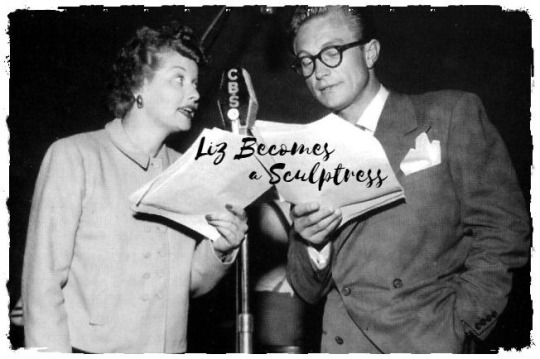
“Liz Becomes a Sculptress” (aka “Liz the Sculptress” aka “Liz Turns Sculptress”) is episode #100 [some sources say #99] of the radio series MY FAVORITE HUSBAND broadcast on October 7, 1950.
This was the fifth episode of the third season of MY FAVORITE HUSBAND. There were 31 new episodes, with the season ending on March 31, 1951.

This program was the basis for “I Love Lucy” episode titled "Lucy Becomes a Sculptress" (ILL S2;E15), first aired on January 15, 1953.
Synopsis ~ Liz decides that she needs a hobby, and the proprietor of the local arts and crafts store convinces her she's a natural artistic genius when it comes to sculpting clay.
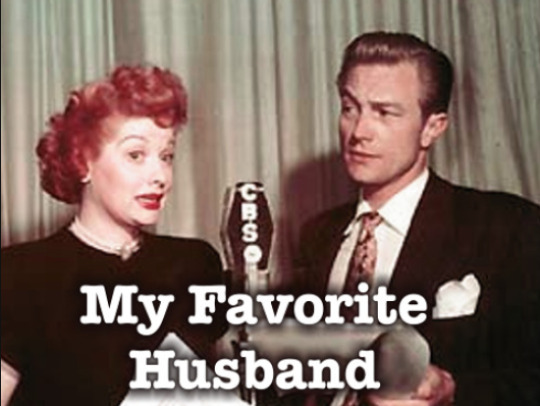
“My Favorite Husband” was based on the novels Mr. and Mrs. Cugat, the Record of a Happy Marriage (1940) and Outside Eden (1945) by Isabel Scott Rorick, which had previously been adapted into the film Are Husbands Necessary? (1942). “My Favorite Husband” was first broadcast as a one-time special on July 5, 1948. Lucille Ball and Lee Bowman played the characters of Liz and George Cugat, and a positive response to this broadcast convinced CBS to launch “My Favorite Husband” as a series. Bowman was not available Richard Denning was cast as George. On January 7, 1949, confusion with bandleader Xavier Cugat prompted a name change to Cooper. On this same episode Jell-O became its sponsor. A total of 124 episodes of the program aired from July 23, 1948 through March 31, 1951. After about ten episodes had been written, writers Fox and Davenport departed and three new writers took over – Bob Carroll, Jr., Madelyn Pugh, and head writer/producer Jess Oppenheimer. In March 1949 Gale Gordon took over the existing role of George’s boss, Rudolph Atterbury, and Bea Benaderet was added as his wife, Iris. CBS brought “My Favorite Husband” to television in 1953, starring Joan Caulfield and Barry Nelson as Liz and George Cooper. The television version ran two-and-a-half seasons, from September 1953 through December 1955, running concurrently with “I Love Lucy.” It was produced live at CBS Television City for most of its run, until switching to film for a truncated third season filmed (ironically) at Desilu and recasting Liz Cooper with Vanessa Brown.
MAIN CAST

Lucille Ball (Liz Cooper) was born on August 6, 1911 in Jamestown, New York. She began her screen career in 1933 and was known in Hollywood as ‘Queen of the B’s’ due to her many appearances in ‘B’ movies. With Richard Denning, she starred in a radio program titled “My Favorite Husband” which eventually led to the creation of “I Love Lucy,” a television situation comedy in which she co-starred with her real-life husband, Latin bandleader Desi Arnaz. The program was phenomenally successful, allowing the couple to purchase what was once RKO Studios, re-naming it Desilu. When the show ended in 1960 (in an hour-long format known as “The Lucy-Desi Comedy Hour”) so did Lucy and Desi’s marriage. In 1962, hoping to keep Desilu financially solvent, Lucy returned to the sitcom format with “The Lucy Show,” which lasted six seasons. She followed that with a similar sitcom “Here’s Lucy” co-starring with her real-life children, Lucie and Desi Jr., as well as Gale Gordon, who had joined the cast of “The Lucy Show” during season two. Before her death in 1989, Lucy made one more attempt at a sitcom with “Life With Lucy,” also with Gordon.
Richard Denning (George Cooper) was born Louis Albert Heindrich Denninger Jr., in Poughkeepsie, New York. When he was 18 months old, his family moved to Los Angeles. Plans called for him to take over his father’s garment manufacturing business, but he developed an interest in acting. Denning enlisted in the US Navy during World War II. He is best known for his roles in various science fiction and horror films of the 1950s. Although he teamed with Lucille Ball on radio in “My Favorite Husband,” the two never acted together on screen. While “I Love Lucy” was on the air, he was seen on another CBS TV series, “Mr. & Mrs. North.” From 1968 to 1980 he played the Governor on “Hawaii 5-0″, his final role. He died in 1998 at age 84.
Bea Benadaret (Iris Atterbury / Miss Crawford) was considered the front-runner to be cast as Ethel Mertz but when “I Love Lucy” was ready to start production she was already playing a similar role on TV’s “The George Burns and Gracie Allen Show” so Vivian Vance was cast instead. On “I Love Lucy” she was cast as Lucy Ricardo’s spinster neighbor, Miss Lewis, in “Lucy Plays Cupid” (ILL S1;E15) in early 1952. Later, she was a success in her own show, “Petticoat Junction” as Shady Rest Hotel proprietress Kate Bradley. She starred in the series until her death in 1968.
It is not unusual for radio performers to double up on voices, especially if they have very little to do as their principal character. Iris only has a brief phone chat with Liz before Miss Crawford’s entrance. It would not make sense to hire another actress for the role when Benadaret was under contract.
Bob LeMond (Announcer) also served as the announcer for the pilot episode of “I Love Lucy”. When the long-lost pilot was finally discovered in 1990, a few moments of the opening narration were damaged and lost, so LeMond – fifty years later – recreated the narration for the CBS special and subsequent DVD release.
Gale Gordon (Rudolph Atterbury) and Ruth Perrott (Katie the Maid) do not appear in this episode.
GUEST CAST

Hans Conried (Carl, Art Store Owner) first co-starred with Lucille Ball in The Big Street (1942). He then appeared on “I Love Lucy” as used furniture man Dan Jenkins in “Redecorating” (ILL S2;E8) and later that same season as Percy Livermore in “Lucy Hires an English Tutor” (ILL S2;E13) – both in 1952. The following year he began an association with Disney by voicing Captain Hook in Peter Pan. On “The Lucy Show” he played Professor Gitterman in “Lucy’s Barbershop Quartet” (TLS S1;E19) and in “Lucy Plays Cleopatra” (TLS S2;E1). He was probably best known as Uncle Tonoose on “Make Room for Daddy” starring Danny Thomas, which was filmed on the Desilu lot. He joined Thomas on a season 6 episode of “Here’s Lucy” in 1973. He died in 1982 at age 64.
The Professor (aka Sam) and Muscles Malcolm the model are played by uncredited performers.
THE EPISODE
ANNOUNCER: “As we look in on 321 Bundy Drive, Sheridan Falls, it's late afternoon. Liz is just arriving home from her club meeting, and is met at the door by George.”
Liz has had a very educational day at the club today. They had a lecture on older people and how they can be kept happy and useful, but as Liz has no hobbies, the lecturer pointed out that she's on a slippery slope to being lonely and unhappy when she gets older. So she's going to get a hobby!
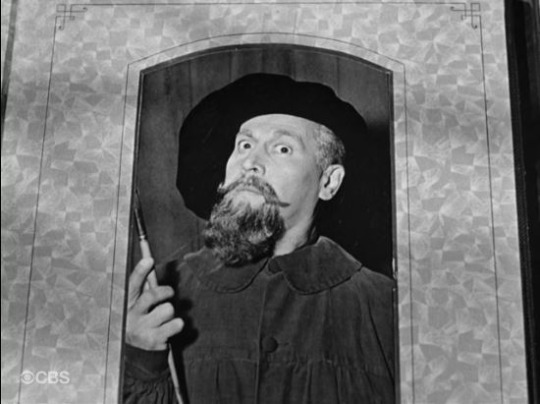
On “I Love Lucy,” the motivation for Lucy Ricardo to take up art as a hobby is so that her baby will be born into a cultured household. Lucy shows Ricky a portrait of her great-grandfather (above), who she says was was a great artist. In reality, this is a photo of writer Bob Carroll Jr., who co-wrote both the radio and television scripts!
After some conversation about who will pre-decease whom (and whether they will re-marry), Liz vows to go down to the art store first thing in the morning to get a hobby.
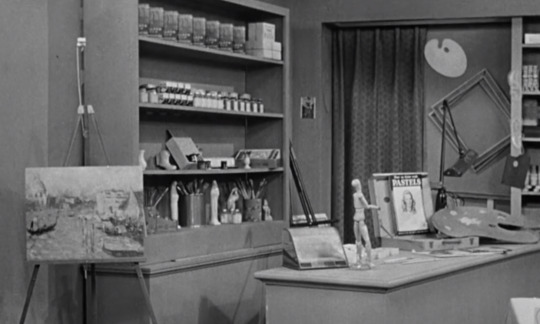
Liz enters Carl’s Arts and Crafts shop and is welcomed by Carl.
CARL: “I have all media. What do you usually like to work in?” LIZ: “Oh, just an old housedress.”

On TV, Lucy is confused by the term ‘media’ and likes to work in ‘an old smock.’ On TV the art store clerk will be played by Russian-born Leon Belasco (right) who had done three movies with Lucille Ball between 1939 and 1944. William Abbott, the shop owner, is played by Shepard Menken.
Liz flirts with the idea of finger painting. After all, she already has fingers!
LIZ: “Are these the right kind of fingers?” CARL: “You can start with those. Later on I’ll sell you some better ones.”
Instead, Carl convinces Liz to try sculpting with their in store clay display. Carl suddenly is taken aback by her handling of the clay! It becomes apparent to the listener that Carl is more salesman that art lover. He gushes over her primative squeezings.
CARL: "All the world is waiting for a squeezer like you!”
Carl calls over an art critic (whom he calls “the Professor”) who just happens to be browsing in the shop. They both fawn over her lump of clay, even falling to their knees in admiration. Liz is convinced to spend $25 on clay and leaves the shop feeling she is destined for greatness. Once she is gone, the men drop their pretense and we learn that “The Professor” is really a clerk named Sam.
CARL: “The next aspiring artist to come in I get to be the Professor. You have all the fun!”
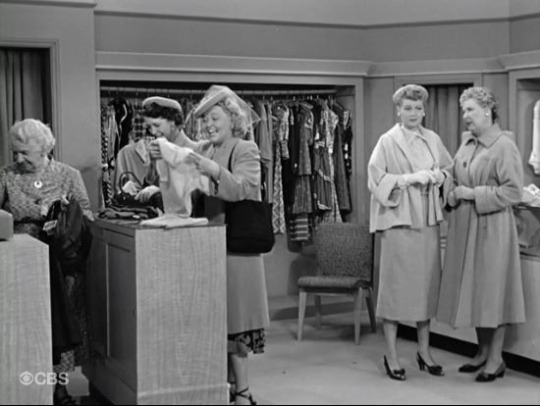
The idea of a convincing a customer to make a purchase by staging a deceptive scenario will also be used on in “The Girls Go Into Business” (ILL S3;E2) in which dress shop owner Mrs. Hansen (Mabel Paige) tries to convince Lucy and Ethel her shop does a booming business by recruiting two ‘shoppers’ (Kay Wiley and Barbara Pepper) to buy lots of merchandise while Lucy and Ethel look on in amazement. The scam works and Lucy and Ethel buy the store.
George comes home from work to find Liz has set up an art studio in his den. To George’s surprise Liz is wearing an artist’s smock and a tam.
LIZ / LUCY: “This is the official outfit of all us sculptressessss.” GEORGE / RICKY: “All us whatressesessss?”
Liz proudly shows off her latest work to George, who teases her about not knowing exactly what it is. Finally, he says it is a bunch of grapes and Liz bursts into tears. She’s sculpted a man’s head!

On TV, Ricky guesses Lucy’s first sculpture is supposed to be a boy and his dog or a girl and her dog but Lucy says it is a child at its mother’s knee. Ethel guesses it is the nose on somebody’s face.
After Bob LeMond does a commercial for Jell-O (”You can turn out a work of art with Jell-O!”), the story resumes with Liz sobbing and George comforting her. Liz says she’d do much better if she could hire a model. George volunteers as her model but Liz quickly rejects him. George asks why.
LIZ: “Your muscles. They’re all in your coat.”
George takes off his coat and shit to prove he has what it takes to model.
LIZ: “Well! Gypsy Rose Cooper!”
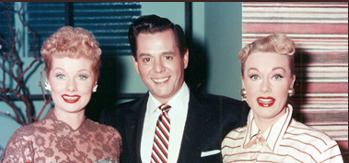
Liz is referring to the famous strip tease artist and burlesque performer Gypsy Rose Lee (born Rose Louise Hovick, 1911–1970), whose life was the inspiration for the Broadway musical and film Gypsy in 1959. Above, Gypsy Rose Lee visited the set of “I Love Lucy” during the filming of “Hollywood Anniversary” in February 1955.
Liz unfavorably compares George’s physique to the Discus Thrower, a Greek sculpture completed at the start of the Classical Period, depicting a youthful athlete throwing discus, circa 460–450 BC. Liz measures George’s ‘bicups’ (biceps) but they fall short.

On “I Love Lucy,” Ricky avoids being a model, but Fred is recruited to pose as the Discus Thrower - and throws his back out in the process!
George scolds Liz for spending so much money on her ‘hobby’ - $50, which is equal to more than $500 in today’s economy. George demands she return everything to the art store and Liz bursts into tears again.
The next day, Liz telephones Iris to tell her that she has hired a model anyway. The doorbell rings and it is ‘Muscles Malcolm’ from the modeling agency. To Liz’s surprise he wants to pose ‘au naturel’ but Liz convinces him to wear a tiger skin.
George comes home early from dinner so Liz quickly stashes Malcolm in the closet. George sees Malcolm’s street clothes. Liz tries to convince him that they are his clothes! Malcolm suddenly sneezes from inside the closet.
LIZ (quickly): “I didn’t hear anything. Nobody sneezed!” GEORGE (suspicious): “I didn’t say anyone did.”
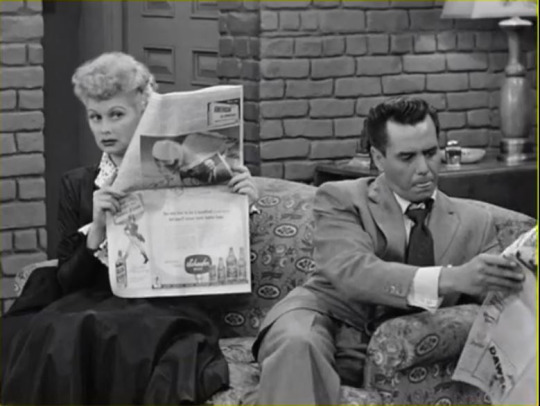
In “The Saxophone” (ILL S2;E2), Ricky stashes a handsome man in the closet to turn the tables on Lucy. Writer Madelyn Pugh remembers: "For some reason, Bob [Carrol Jr.] and I liked the idea of people hiding in a closet. We used it in this show, and in a couple of other 'Lucys.’ We even used it in the pilot of 'The Mothers-in-Law’ fifteen years later – and it always got a laugh!”
The jig is up and Malcolm emerges from the closet. Surprisingly, George is not mad at all. He leaves the house calmly, but Liz smells a rat.
George returns with a giggly girl named Miss Crawford (also Bea Benadaret). George is going to take up painting and Miss Crawford is his model.
MISS CRAWFORD: “Do you want me to pose draped or undraped? I usually pose undraped.” LIZ: “Draped. You’ve got a bad enough cold already.”
NOTE: This line gets the biggest audience reaction of the entire episode, perhaps because of the intimation of nudity or because Bea Benadaret’s voice sounds very scratchy. Perhaps the audience knows that she is under the weather and feels in on the joke?

In the live Jell-O commercial, Lucille Ball, in a seductive voice, tells Bob LeMond claims she always wanted to be...a ballet dancer! Instead, Ball switches to her “Professor” voice; a deep, husky, and blunt tone.
LUCILLE BALL: “I ain’t gonna do the Jell-O jiggle. I had an accident. I had on my new shoes; they’re kinda sharp. I spun six times. Once for strawberry like this. Once for raspberry like this. Once for cherry, like so. And once for orange, lemon and lime, like this. Darn that Jell-O jiggle, I dun it again. I dug myself right into the ground!”

ANNOUNCER: “Lucille Ball can currently be seen in Columbia’s laugh-fest ‘The Fuller Brush Girl’. Watch for it when it comes to your city.”
A recorded commercial for Instant Sanka coffee and the Jell-O jingle ends the broadcast.
FAST FORWARD!

The television version of this script ends very differently. Lucy tries to pass off her own head as an example of her art work. Ricky invites an important art critic to assess it, and he attempts to buy Lucy’s head and take it with him! The highly visual ending, with Lucille Ball’s head stuck through a table and covered with clay, works much better than the radio conclusion.
This isn’t the last time Lucy had a brush (pun intended) with the visual arts.
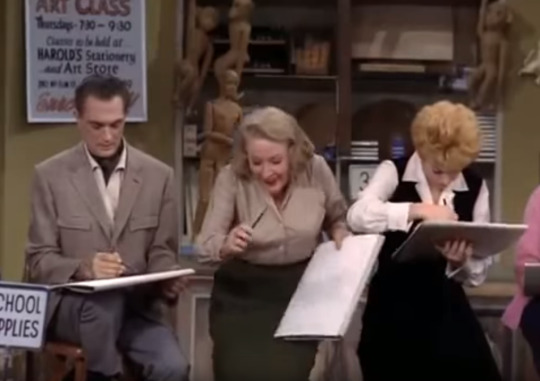
In “Lucy Goes To Art Class” (TLS S2;E15) in 1964, Lucy Carmichael also visited an art store and took a drawing to meet an eligible bachelor (Robert Alda).

In “Lucy and Uncle Harry’s Pot” (HL S5;E21) in 1973, Lucy Carter took up pottery in order to recreate a vase she’s broken which had sentimental value to Harry.
#My Favorite Husband#Lucille Ball#Richard Denning#Hans Conried#Bea Benadaret#Sculpting#Clay#Art#I Love Lucy#Desi Arnaz#Fuller Brush Girl#Discus Thrower#Here's Lucy#The Lucy Show#Jello#Bob LeMond#Gypsy Rose Lee
4 notes
·
View notes
Photo

Paul Laurence Dunbar High School is a public school located in DC. The school was America's first public high school for African Americans. As all public school teachers were federal civil servants, the school's teachers received pay equal to white teachers. It attracted high-quality faculty, many with advanced degrees, including doctorates. Parents sent their children to the school from across the city because of its high standards. Many of its alumni graduated from top-quality colleges and universities and gained professional degrees. The school was founded in 1870 as the Preparatory High School for Colored Youth. From 1891-1916, it became known as M Street High School. When its location was changed from M Street, the school was renamed in 1916 for the noted African-American poet, Paul Laurence Dunbar. Dunbar was designated as an academic high school, with other schools providing more vocational or technical training. Dunbar was known for its excellent academics, some African Americans moved to DC so their children could attend it. The school boasted many graduates who went on to higher education and a generally successful student body. The school has graduated many well-known figures of the 20th century, including Sterling Brown, H. Naylor Fitzhugh, Nannie Helen Burroughs, Charles R. Drew, William H. Hastie, Charles Hamilton Houston, Robert Heberton Terrell, Benjamin O. Davis Jr., Paul Capel, III, Robert C. Weaver, and James E. Bowman. Its faculty included Anna Julia Cooper, Kelly Miller, Mary Church Terrell, A. A. Birch Jr., Carter G. Woodson, and Julia Evangeline Brooks, who was a graduate of the school. Among its principals were Anna J. Cooper, Richard Greener, Mary Jane Patterson, and Robert Heberton Terrell. An unusual number of teachers and principals held Ph.D. degrees, including historian Carter G. Woodson, the second African American to earn a Ph.D. from Harvard. Until 1954, Fairfax County, Virginia, had no secondary schools for African Americans. Dunbar and several other District of Columbia public schools accepted african americans from the county before that time. #africanhistory365 #africanexcellence https://www.instagram.com/p/Co4xwTXr-CY/?igshid=NGJjMDIxMWI=
0 notes
Text

THEODORA 'THEO” LUTESSA MERCER who strongly resembles HAILEE STEINFELD, has been spotted in Pandæmonium. The CISFEMALE is a TWENTY FOUR year old TAGALOG DEMIGODDESS (DAUGHTER OF MAYARI), and has been in Pandæmonium for TWO YEARS. I hear they’re RESOLUTE & MERCIFUL and IMPULSIVE & STUBBORN. If you’re lucky you may catch them working at CLUB 390 as a BOUNCER.
born the daughter of a mortal and the goddess mayari, theo was raised solely by her father. her childhood was… complicated. they were constantly traveling, rarely in on city, state, or even country for more than a few weeks. theo still doesn’t know what her father did professionally, but with the way they always had money to travel with but never had money to spend, she’s sure it wasn’t legal.
one night when theo was about seventeen, she and her father were in crete, greece and they were attacked in their hotel room at night, by exceptionally powerful people — people that rivaled her own physical strength. after surviving the initial ambush, they quickly gathered their belongings and fled through the city, but they only managed to get away and hide for a few hours. during that time, her father finally explained to her what she was, and why she had the abilities that she did. she was a demigod. and they were most likely attacked in greece because her mother was a goddess, but she wasn’t of the greek pantheon. he told theo her mother’s name, mayari, and before she could even ask for any explanations, they heard their pursuers nearby and closing in on them. her father handed her a vial of what seemed like blood, told her a woman’s name, wanted her to seek her out to perform a “confirmation spell” and if there were hits, to track them down and find her brother. theo was so confused about everything, but most of all she was confused on why her father was telling her all of this now. before she had the chance to ask, she was told to run, and her father revealed himself as a distraction to their pursuers. that was the last time she ever saw her father, and she doesn’t know if he’s alive or dead.
theo did what she was told, traveled to delphi and found the witch her father told her about. she performed the spell, and with little to nothing to go off of, she tracked down every last relative on the map she was given. some of them she introduced herself to, some of them she felt she was better off not knowing, some of them really made theo question the integrity of her heritage, but none of them could have been her brother. well, not unless her dad conceived a kid while he was twelve, which she was fairly sure he hadn’t. none of them that is, until half a decade later. the. very. last. one. she traveled down to the small town a little outside of new york not really knowing what to expect — about her final relative, or about a the place that just oozed this vibe she couldn’t explain. it felt almost like a home, but it felt cold too. some of the people she saw there looked at her like they were thinking she’d make a nice lunch. it wasn’t until she spent a few days there and learned a little more about the town that she realized they probably were. she wasn’t sure what to expect when she finally caught the trail of the man she was looking for, but when theo finally saw him, she didn’t have much doubt. he seemed like a bit of an ass, sure, but the guy was practically a spitting image of their father. there was no mistaking it. tj williams was her brother.
for a couple weeks, theo did probably the creepiest thing she could have done. she followed him around, just observing and learning. like a stalker. but with good intentions. she was just a little nervous. really, she didn’t even know whether she should introduce herself or not. from what she could tell the guy was a real asshole, and technically her father never told her to go form a bond or anything, but she knew that’s what he’d really meant. so theo just kind of… inserted herself into tj’s life the best way she could think of. by the next week, she’d already made headway in befriending some of her brother’s… associates? friends? she wasn’t sure yet, but she’d worked herself in, and eventually, she’d fully integrated herself into the group of warriors. honestly, beyond even just knowing her brother — who she still hadn’t told about their connection — she felt like she’d finally found somewhere she belonged. a group of people she felt a bond with more than any of the relatives she’d found along the way. now she’s just worried that one day the secret will get out, and the life she’s built here will come tumbling down.
the goddess mayari was once known as the ruler of many things to the tagalog people. the goddess of combat, the goddess of war, revolution, the hunt; the goddess of strength and beauty; the goddess of the moon and the night. those domains of power manifest themselves in theodore mercer in many ways:
theo rarely sleeps. she’s awake all hours of the night, and only really needs rest the night after a difficult fight or other very strenuous activities. without strenuous activity, theo can easily go about five days with only a few hours rest.
has innate skill when it comes to hunting and fighting, and coupled with extensive training, she’s become an expert bowman, rifleman, and melee combatant that can easily rival the most experienced hunters due to her other abilities. she’s also an expert tracker, and once went “camping” for three months, relying on her ability to track, hunt, and gather to survive.
theo can see clearly at night. even in a pitch black room, she would have the visibility of a normal human under dim light.
additionally, she has the common abilities and weaknesses displayed in most demigods.
quiet, but not shy. reserved, but not afraid of conflict. theo is more comfortable when watching and listening, observing rather than being the center of attention. when she has something to say however, she says it, and when she has a strong opinion she makes it known. she’s also very stubborn, so when she makes up her mind about something, she doesn’t back down easily.
will show mercy when possible. she has no interest in needless killing, so despite being quite adept at it, she doesn’t often take lives. only when it’s required of her.
theo might come off as intimidating, but she’s really kind of a teddy bear once you’re in her good graces. she’s really protective over the people she cares about and will bend over backwards to make them happy.
will happily throw down a beer or two or ten or fifty with her friends or comrades. she’s not above getting completely shitfaced and having a good time. hell, getting her wasted is the best way to make her open up a bit.
loves stargazing. she feels her connection to the night sky, though she’s not sure she even believes any of the stories about her mother. goddess of the moon, ruler of the entire night? she just can’t buy it completely. especially not when she knows other demigods who were born from gods and goddesses from other mythologies. she doesn’t understand how it can all be real and all fit together when almost all of it contradicts everything else.
never had a formal education, her father taught her on occasion, but he was often busy. that’s not to say she’s not intelligent, however. while theo might not know advanced calculus or physics, it’s only because she was never taught. she’s an adept problem solver, quick learner, good at critical thinking, and well-spoken enough to keep it from being glaringly obvious she didn’t go to school.
she’s a really good artist. she only treats it as a hobby or a way to pass the time (especially since she doesn’t sleep much), and will do everything she can to downplay her talent and any compliments she receives, but she’s really good. she started out just sketching little things that caught her eye, but then eventually she graduated all the way up to painting the night sky. sometimes she’ll sit outside all night long with her easel and paints, and from one side of the canvas to the other, she’ll paint a gradient-like mural from whenever she starts to the sunrise, showing different things that happen throughout the night. for example, a cat that crosses her path, or a fight that breaks out on the street, or the one random car that happens to drive by at three in the morning. it’s her favorite thing to do artistically and she’s probably done about four or five so far, each from different locations.
#► theodora lutessa mercer#pandemonium: intro#// long ass intro my goddd lmao#// tag drop:::#inspo → theo#mirror → theo#starter → theo
5 notes
·
View notes
Text
- ̗̀ ❝ where they at now !!

a list from royalty - 1 x 1 ( because i’m bored and instead of doing my homework... i want to do this. ) anyway @ me hoooes LETS PLOT
royalty:
victor gabriel bartolome ( douglas booth ) — king of spain, doting father of a perfect little girl, who’s going to be queen someday. focusing on the new world, bc LAND TO CONQUER he wants to live up to his momma tbh. currently sharing his wife with his best friend because he died that one time it’s #complicated.
elizabeth penelope adair * nee of kent * ( adelaide kane ) — princess of england, duchess of kent & many more, eternally pregnant will probably die pregnant. married and stupid in love... literally making heart eyes at her husband from across the hall her family thinks it’s disgusting. if you can’t find her she’s having sex. mother of many children and cats. currently crying about donna, being fat and yellow lemons.
sofia fatima adair * nee de andrade * ( selena gomez ) — princess of england, duchess of whatever her husband owns lmao, eloped because she and her husband have a sense of adventure. working on the marriage thing and dealing with the fact that hubs has *wiggles eyebrows* past. ignoring her best friend bc she married french. thinks the king of england is god, prays to him daily and she steals all the flan in order to make elizabeth cry
maximiliano de andrade ( chace crawford ) — royal duke of burgundy, right hand of the spanish king, little brother who acts like the eldest. constantly worried about his sisters and brother. he married vg’s wife once because he died. currently figuring out how the sex works #lovetriangles
gabriel de andrade ( gregg sulkin ) — royal duke of ( what duchy was anne’s? lmfao ), married to the eternal bane of his existence he calls her hades for short. some people call her a princess but he thinks that’s a lie. they fight 24/7 but they are also in love 24/7. he built her a castle because they are little dicks that want to be alone, don’t try to find them they are always on vacation. annoyed at his family, and currently making friends in france, ( only one who went to annie’s wedding tbh. ) while working on the having kids thing.
beatriz de andrade ( maia mitchell ) — royal duchess of burgundy, no one knows she exists tbh. in fact she’s a myth because she’s always inside and her face is always hiding behind a book. does she talk? does she eat? nobody knows.
dimitri fontaine iv ( bradley james ) — the vegan king of france, grew up a bastard until his father married his mom and legitimized him. not prepared to be king, noblest heart and he’s trying his best. loves his sisters more than life, ( he’s the face, they the brains tbh. ) newly wed and he still can’t believe it. completely devoted to his wife, it’s why france only eats meat when guest come to court. working on his country’s image and trying to open doors in other countries. also it’s france, let them eat cake!
gabrielle fontaine ( sophie turner ) — princess of france & duchess of bourbon, cooky inventor and military genius all she aspires in life is to lead an army. proficient in weaponry and other things v. educated, will stare down generals just about every day of the week. extremely proud of france and her siblings ( they are her life ) not entirely happy with the idea of outsiders even if she knows it’s necessary. currently refusing to accept any marriage proposals because she’s an independent princess who needs no man. ( rich can call her tho )
fairwood:
alexandra sophia ford ( dove cameron ) — jason ford’s favorite little sister ( she the only one, but she uses the title anyway ) literally pulled out of a disney fairy-tale with a prince to match. she’s v. in love ( first loves and all that ) experiencing the magic of sex before marriage for the first time while trying that whole long distance thing because she attends college at yale. her niece and nephew are the most important, she has bought out every toy store on the east coast. currently ignoring her parents and student responsibilities bc english dick.
riley daphne moore ( katie stevens ) — crazy cupcake lady and momma bear. she’s all about protecting the kiddos, and will more often than not attempt to feed them cupcakes. owner of queen of tarts and in love with the grumpy diner owner... who’s heart she broke because she’s leaving. bakery in the works of becoming a franchise, but she’s currently v. sad. so it’s been closed and people think she died.
gemma allegra ford * nee rhodes * ( amber heard ) — boss lady. ready to rule the world, a queen of an empire and a wife. she fell in love with her husband without wanting to so she’s in a constant state of discovering emotions. ( tbh she wants a refund, she hella lost lmao. ) don’t breathe near her kit, she’ll eat you. that girl is the other half of the heart she didn’t even know she had. dealing with the school teacher’s ever annoying presence and coming to terms with the fact that she might have to share her husband for the rest of her life. oh + she’s plotting to kill the village idiot on a now regular basis... &. yes she means finn.
finnley gray ( richard madden ) — resident village idiot, ex trust fund brat who gave it up bc he has a passion for literature and teaching. a best selling author he’s still rich but like not at his family’s level ya feel? the best best friend you’ll ever have, just ask his. neurotic, don’t look at the mini me’s bc he’ll eat you. currently sexing it up with his ex fiance... the lady at the bar while in love with a brunette at least he thinks he is. man whore who won’t ever change or will he? dunno don’t ask me... he should be in jail he’s mr. fitz
athena margaret pearce ( carlson young ) — ex wild child who is now in a committed relationship with her best friend. thea’s had a dramatic year, you know going from slutting it up with everything that moves to falling in love with the one person she’s known her entire life. people can’t believe that it’s her tbh. basically she’s v. gay for her bff... + don’t breathe in cassie’s direction because she’ll STILL eat you.
james cunningham ( grant gustin ) — still summer’s life partner, ubber nerd. he got into all the ivy leagues but he decided on MIT. he’s best friends with satan, and he still does her homework so he’s basically double majoring. never got his bike back from fish and he’s still mad about it lmao. oh and he still don’t know what flirting is.
tree hill:
natalie evans ( virginia gardner ) — jailbait, sixteen... and completely and totally her father’s twin. that’s the reason clay won’t forget her. pain in the ass to her eldest brother, secretly into music. trying to be a touch bitch but she really just want to sign the toaster strudel song. she shares everything with sawyer, from food to boys.. they’ll share the clap one day and call it boding. currently still crushing on chris k jr... but he refuses to take her seriously. he still her boing thoo.
james lucas scott ( luke mitchell ) — golden boy, future NBA star like his daddy. momma’s boy, going to school and shooting hoops that’s his life. he does what he’s supposed to when he’s supposed to because that’s what’s expected of him. he’s gotta learn to live a little and he really needs to put on his big boy pants and ask madison out again. fighting his little sister 24/7 because she drives him insane and a man can only take so much.
andrew chase adams ( matthew daddario ) — hates everyone and everything... broods 24/7. only reason he ever goes anywhere is to keep an eye on his little sister.
davis baker ( daniel sharman ) — the smart baker, total nerd... collects action figures and is totally into the superhero thing. loves his cousin sawyer like a sister... and has a crush on laney but he’s afraid to talk to her so he hides from her. she thinks he hates her, but he just don’t know how to talk to a girl.
dionne taylor ( candice patton ) — girl genius, 1000% woke, she’s cultured bc she has a mixed family she knows how white people live too. no one ever knows what she’s talking about except her brother bc they are basically both jimmy neutron.
ayto:
bailey anderson ( adelaide kane ) — resident southern nut job, a man eater at least that’s her label but tbh it’s more like a people eater bc she’s gonna steal someone’s girl. fun and adventurous, basically an alcoholic with loads and loads of intimacy issues. she wants to win the million dollars
fitzgerald ‘ fitz ‘ matthews ( matthew daddario ) — friendzoned, doesn’t know how to tell a girl he likes, that he likes her so it’s just so ???? needs someone to set him straight and he needs to find love.. he don’t cur about the 1 mil.
suburbs:
lena harris ( zoey deutch ) — her ex came to pick up their daughter... they had mind blowing sex and tbh that’s STILL what they are doing. she lives and breathes for her daughter tho... basically everyone knows that she and aaron are still in love with each other except thai lmao.
william preston collier ii ( joshua bowman ) — ceo, is cleaning up his dad’s mess of a company. christian vasquez’s business partner... and in love with lissa. did he leave lily yet? is he going to? idK where we at here.
holly rose fisher ( danielle campbell ) — still throwing phones at christian’s head. the ER knows them by first name by now.
oliver paige ( aaron taylor johnson ) — marrying and divorcing bobbi... if he married he’s the happiest in the world and totally in love. if he divorced he’ll be telling ‘ how i found out my wife was satan stories ‘ to anyone who is willing to listen. rich af, spending his trust fund and hasn’t worked a day in his life bc #lazy
charlotte vasquez * nee moore * ( ashley benson ) — married mr. vasquez, she is christian’s step mom. a lady of leisure.. spending her millions and looking fab while doing it.
forties:
alexandra frederick * nee garroway * ( danielle campbell ) — 1/2 of the bitter squirt squad. was married to a fat head and they had a daughter who is three years old. her name is alison vivianne frederick ( sabrina carpenter fc. ) bobby died a year ago, she’s still angry about it and tbh avoids talking about hubs because she’s pissed as f at him for dying. his hero flag? it’s rotting away in her closet and she might burn it at some point bc she’s insane. still has 10 dogs, lives with ruby now... and rubes is the only person she talks to... you know outside of her brother ( cause she can’t make nathan scared of her... she tried tho )
theodore ‘ teddy ‘ gallagher ( nathaniel buzolic ) — went back to the air-force after you know that whole we blew up a house fiasco... so he got his wings back... did more things for his country and he’s had enough of war to last him a life time so when he was given the chance to leave he did. he got real involved with helping soldiers with ptsd and he runs a center for it now. idiot is in love with juliette, told her on new years she said thank you and now he’s just like ???? still sticks around tho bc like that’s his crazy ya feel?
roxanne luz * nee wade * ( amber heard ) — cougar, met the love of her life at a bar... went on a few dates and then married her man in a foreign country... not even sure it’s legal but whatvs. they had a kid... his name is bacon. bat shit crazy, while being a hippie is a new concept and she’s working on it. always traveling the world and seeing exotic places. sends everyone post cards. only comes back to see her spice... aka juliette bc crazy bitches gotta tough it out together.
panthers:
lyra hahaway ( lily collins ) — at yale, no longer the virgin mary... because she and the bf did the sex. she had a blast, doesn’t remember what purity means. still the blakes #1 fan. visits texas to see them all the time, and is the best god mother anyone will ever meet. oh and she stalked jeremy from a bush once she’s not allowed to hang out with tizi because of it.
samuel calhoun ( grant gustin ) — moved to california, is at UCLA...still getting knives and anything that’s dangerous thrown his way. dating laura bc he has a death wish, and he’s working while getting his degree and taking care of his younger siblings bc their mom is in a psychiatric wing
ophelia ferro ( nina dobrev ) — FBI, she and cj haven’t seen each other in years bc he’s now wanted ( idk that was the plot. ) still hates dillon... matty still mad at her about the drake joke. she’s in a committed relationship with her gun.
southern:
amelia nichols ( lily james ) — gave a cowboy a lap dance, then had sex in his car... gave him another lap dance on new years eve and almost killed him bc of it. her dad wants her to go back to the city so she can keep working on her brilliant medical career, but her crush on said cowboy won’t let her.
gale hawthorne ( richard madden ) — modern southern hero who needs no princess, except he does in love with shawn but won’t tell her bc she has her real prince charming. ( can’t even hate him bc he’s too good ) had a chicken named gabent and it died.. he and bentley had a funeral for it and the entire town came.
edward nichols ( max irons ) — still has no idea that his wife? is it wife? wife to be? point is he still don’t know that she was married once before or who gale is. loves his twin sister mia and is basically in town bc shawn is there. also he’s that annoyingly nice guy in all the movies that you just can’t hate bc he’s too good.
1 x 1: aka the jess verse basically
dr. josephine blake ( karen gillan ) || v.crime — forensic anthropologist, woman genius... digging up bones and eternally taking out her sexual frustration by fighting her partner 24/7. she owns a v. big gun
dr. riley scott ( nina dobrev ) || v. hospital — emotional mess, doesn’t know how to do relationships but she wanted to... and then she kissed the love of her life on new years and his wife showed up. she’s currently bitter and mad at the world. oh and she pretends not to care about her kid sister but she’ll eat you if you look at her.
caitlin sullivan ( adelaide kane ) || v. pride and prejudice — grad student with a youtube channel dedicated to hating carter.
daniela echavarria ( selena gomez ) || v. hollywood — married to the love of her life, is v. happy for now.
name to be decided ( matthew daddario ) || v. star wars — basically gonna be male leia... i will pick a name someday LMFAO.
#& ; character master list.#& ; talk tag.#I WILL NEVER EVER DO THIS AGAIN#so no one ever @ me#if i add new chars they will be here in spirit bc damn
8 notes
·
View notes
Text
Valerie Jarrett






Valerie June Jarrett (née Bowman; born November 14, 1956) is an American who was Senior Advisor to the President of the United States and Assistant to the President for Public Engagement and Intergovernmental Affairs in the Obama administration from Jan. 20, 2009 to Jan. 20, 2017. She is a Chicago lawyer, businesswoman, and civic leader. Prior to that she served as a co-chair of the Obama–Biden Transition Project.
Early life and education
Jarrett was born in Shiraz, Iran, to American parents James E. Bowman and Barbara Taylor Bowman. One of her maternal great-grandfathers, Robert Robinson Taylor, was an architect who was the first accredited African American architect, and the first African-American student enrolled at the Massachusetts Institute of Technology.
Her father, a pathologist and geneticist, ran a hospital for children in Shiraz in 1956 as part of a program where American physicians and agricultural experts sought to help developing countries' health and farming efforts. When she was five years old, the family moved to London for a year, later moving to Chicago in 1963. Her parents were both African-American; on the television series Finding Your Roots, genealogical research and DNA testing indicated that Jarrett also has French, Scottish, and Native American ancestry. As a child, Jarrett spoke Persian and French. In 1966, her mother was one of four child advocates that created the Erikson Institute. The Institute was established to provide collective knowledge in child development for teachers and other professionals working with young children.
Jarrett graduated from Northfield Mount Hermon in 1974. She earned a B.A. in psychology from Stanford University in 1978 and a Juris Doctor (J.D.) from the University of Michigan Law School in 1981. On May 22, 2016, Jarrett received an honorary degree from Colby College in Waterville, Maine.
Career
Chicago municipal politics
Jarrett got her start in Chicago politics in 1987 working for Mayor Harold Washington as Deputy Corporation Counsel for Finance and Development.
Jarrett continued to work in the mayor's office in the 1990s. She was deputy chief of staff for Mayor Richard Daley, during which time (1991) she hired Michelle Robinson, then engaged to Barack Obama, away from a private law firm. Jarrett served as commissioner of the department of planning and development from 1992 through 1995, and she was chairwoman of the Chicago Transit Board from 1995 to 2005.
Business administration
Until joining the Obama administration, Jarrett was the CEO of the Habitat Company, a real estate development and management company, which she joined in 1995. She has been replaced by Mark Segal, a lawyer who joined the company in 2002, as CEO. Daniel E. Levin is the chairman of Habitat, which was formed in 1971. Jarrett was a member of the board of Chicago Stock Exchange (2000–2007, as chairman, 2004–2007).
She was a member of the Board of Trustees of the University of Chicago Medical Center from 1996 to 2009, becoming vice chairwoman in 2002 and chairwoman in 2006. She also served as Vice Chairwoman of the Board of Trustees of the University of Chicago and a Trustee of Chicago's Museum of Science and Industry. Jarrett serves on the board of directors of USG Corporation, a Chicago-based building materials corporation.
Jarrett's previous year's income, in a 2009 report, was a $300,000 salary and $550,000 in deferred compensation from the Habitat Executive Services, Inc. The Wall Street Journal also reported that she disclosed receiving payments of more than $346,000 for service on boards of directors that reflect her political ties, work in Chicago real estate, and Chicago community development. She was paid $76,000 for service as a director of Navigant Consulting, Inc., a Chicago-based global consulting group with governmental clients. She received $146,600 from USG and $58,000 to serve on the board of Rreef American REIT II, a real estate investment trust based in San Francisco. The Chicago Stock Exchange, Inc., paid her $34,444.
Advisor to Barack Obama
Jarrett was one of President Obama's longest serving advisors and confidantes and was "widely tipped for a high-profile position in an Obama administration."
On November 14, 2008, President-elect Barack Obama selected Jarrett to serve as White House Senior Advisor and assistant to the president for intergovernmental relations and public liaison.
Jarrett was one of three senior advisors to President Obama. She held the retitled position of assistant to the president for intergovernmental affairs and public engagement, managed the White House Office of Public Engagement, Office of Intergovernmental Affairs, and Office of Urban Affairs; she also chaired the White House Council on Women and Girls and the White House Office of Olympic, Paralympic, and Youth Sport. She was part of the US State Visit to the UK in May 2011.
She said that the 2011 report Women in America, which the administration produced for the Council on Women and Girls, would be used to guide policy-making.
Jarrett had a staff of about three dozen and received full-time Secret Service protection. Jarrett's role as both a friend of the Obamas and as senior advisor in the White House was controversial: Robert M. Gates, former Secretary of Defense, objected in his memoirs to her involvement in foreign security affairs; David Axelrod reported in his memoirs Rahm Emanuel's attempts to have her selected as Obama's replacement in the Senate, due to concerns about the difficulty in working with a family friend in a major policy role.
Additional leadership positions
In addition to being senior advisor to the president, Jarrett held other leadership positions and completed further duties. Among those included chairing the White House Council on Women and Girls and co-chairing the White House Task Force to Protect Students from Sexual Assault.
Relationship with President Obama
In 1991, as deputy chief of staff to Mayor Richard Daley, Jarrett interviewed Michelle Robinson for an opening in the mayor's office, after which she immediately offered Robinson the job. Robinson asked for time to think and also asked Jarrett to meet her fiancé, Barack Obama. The three ended up meeting for dinner. After the dinner, Robinson accepted the job with the mayor's office. It was at this time that Jarrett reportedly took the couple under her wing and "introduced them to a wealthier and better-connected Chicago than their own." When Jarrett later left her position at the mayor's office to head Chicago's Department of Planning and Development, Michelle Obama went with her.
In popular culture
Along with Donna Brazile, vice chairwoman of the Democratic National Committee, she is one of the real-life political figures to cameo as herself in the CBS drama The Good Wife.
Personal life
In 1983 Jarrett married William Robert Jarrett, son of Chicago Sun-Times reporter Vernon Jarrett. She attributes her switch from a private to a public career to their daughter Laura's birth and her own desire to do something that would make their daughter proud.
To one reporter's emailed question about her divorce, she replied, "Married in 1983, separated in 1987, and divorced in 1988. Enough said." In a Vogue profile, she further explained, "We grew up together. We were friends since childhood. In a sense, he was the boy next door. I married without really appreciating how hard divorce would be." William Jarrett died in 1993 at age 40, and at the time of his death was director of obstetrics and gynecology at Jackson Park Hospital.
Wikipedia
21 notes
·
View notes
Text
0 notes
Text
History of Pitt Libraries
This post is an adaptation of the Libraries at Pitt exhibit that was featured in the Hillman Library ground floor lobby during Homecoming.
The libraries of the University of Pittsburgh have been in a constant state of progression dating back to the school’s very beginnings. Hugh Henry Brackenridge, founder of the University’s predecessor the Pittsburgh Academy, wrote in his 1792 novel Modern Chivalry that “men in the learned professions require propinquity to the libraries of Apollo as well as the seats of the Muses,” indicating the importance he placed on books and education. After becoming the Western University of Pennsylvania in 1819, the school’s library grew, only to be completely lost in the Great Fire of 1845. The University and its library rose from the ashes even stronger than before, accepting its first major gifts of book collections and hiring its first trained librarian. As the University of Pittsburgh (renamed in 1908) grew from a local to a national and then an international university, so too did the library collection, necessitating the construction of the school’s first standalone library building, Hillman Library, which opened in 1968. As we celebrate fifty years of Hillman Library, we are looking back at the history of libraries at the University of Pittsburgh.
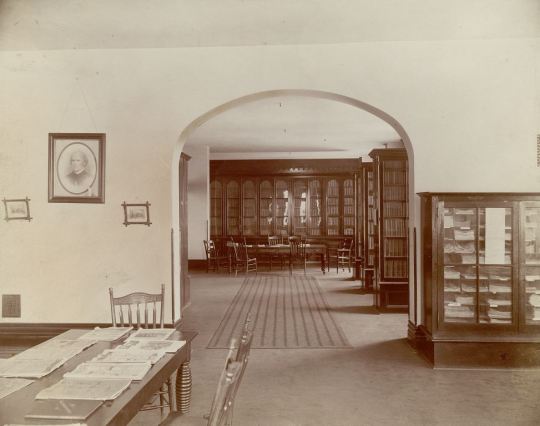
WUP library on the second floor of the Perrysville Avenue building. Western University of Pennsylvania (W.U.P.) Libraries Early in the University’s history, teaching faculty controlled the library collection. Already in 1822, students were responsible for paying for any damage they did to books; however, if the guilty party could not be identified, the charge was distributed among all of the students. While the original W.U.P. library was destroyed in the 1845 fire, by 1861 the library contained about 2,000 volumes. Additional titles were held in the members-only libraries of the Irving and Philomathean Literary Societies. The modern University library collection traces its roots to the 1874 gift of Robert Watson’s library, comprising over 2,000 volumes on mathematics, science, and ancient and modern languages. This was followed by the establishment of a reading room and the designation of the first University Librarian, Greek Professor Joseph F. Griggs, in 1878. In January 1890, the first student assistant was hired to oversee the periodicals room in W.U.P.’s Perrysville Avenue building. As W.U.P. set its sights on its future in Oakland as the University of Pittsburgh, it hired Catherine Elston as the school’s first trained librarian in 1905. In 1907, brothers Peter and John Alldred donated a recreational reading collection and endowment, respectively, which was to remain separate from the rest of the University’s holdings.
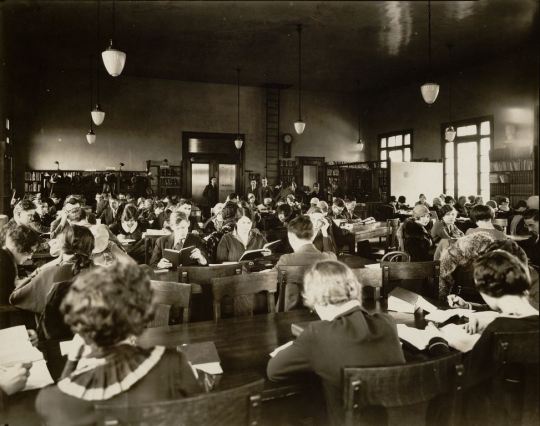
A packed reading room in State Hall. State Hall “The Library is to the University, as a whole, what the laboratory is to Physics, Chemistry, or Biology.” – Chancellor Samuel B. McCormick, 1920 With Pitt’s move to Oakland in 1908, the library was relocated to the first floor of its first new building, State Hall. This location proved inconvenient, as it was adjacent to the School of Mines laboratory, so in 1917 the library was moved to a larger room on the building’s second floor. The growing library was relocated again to State Hall’s third floor in 1919, but the students and faculty deemed the new location inaccessible and use began to decline. As a result of the inconvenient main collection location, departmental libraries began to prosper throughout campus. One example, the Fine Arts library, was funded by Helen Clay Frick beginning in 1927 and it quickly became one of the premier libraries of its kind in the country. By 1930, the Fine Arts library contained over 12,500 volumes, 50,000 photographs, and 15,000 lantern slides illustrating artwork from various places and times. The library and the University continued to grow throughout the early twentieth century until it became clear to Chancellor John Bowman that a new building was needed on campus: one that could accommodate students, faculty, and the expanding collection of libraries for years to come.
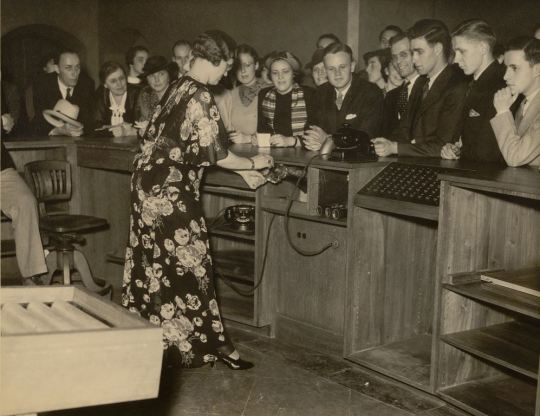
Cathedral of Learning library service desk. The librarian is using a pneumatic tube to send book requests to the stacks below. Cathedral of Learning “In the Cathedral, the library was a mystery. It was spread out among several floors – most were closed stacks.” – Charles Aston, Special Collections Over 30,000 volumes and library equipment were transported at night from State Hall to the Cathedral of Learning between April 29-May 1, 1936, and an additional 40,000 volumes remained available via messenger service until they were eventually relocated that summer. These materials were removed from the third floor of State Hall via a specially designed chute that delivered the boxes to trucks waiting to transport them to the Cathedral. On May 4, 1936, the libraries opened for use on the Cathedral’s fourth, fifth, and sixth floors. Pneumatic tubes transported book requests called call slips to students working in the stacks and retrieved items were delivered to the fifth floor on an electric conveyor. There were separate reading rooms for men and women. The library in the Cathedral was filled with heavy wooden furniture and bookcases; the spaces were stereotypically quiet with little interaction among students. The windows were opened in the summer to cool the stifling spaces, but that also allowed the smoky Pittsburgh air into the stacks, creating a layer of dirt. Less than 25 years after the Cathedral opened, the library was already outdated and overgrown. It became clear that the solution would be to build a standalone library building to accommodate the expanding collection and rapidly changing library services and technologies.
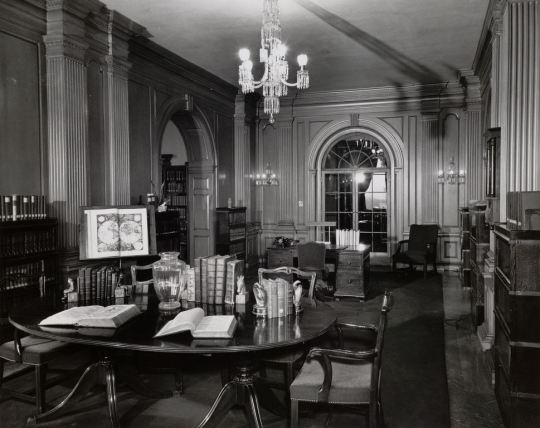
The Darlington Library in the Cathedral of Learning. Darlington Library In 1918, Mary and Edith Darlington initiated the first million dollar gift to the University when they donated their father, William Darlington’s, library to Pitt. Once the bulk of the estate was received in May 1925, the University became the owner of an extensive library of books, manuscripts, atlases and maps pertaining to early American history, particularly that of western Pennsylvania. The collection also included many Victorian English first editions acquired by William’s son, O’Hara, and a complete set of Audubon’s Birds of America. Initially located in State Hall, the Darlington Library moved with the general collection to the Cathedral of Learning in 1936. Situated on the sixth floor of the Cathedral, the entrance was distinguished by wrought iron gates designed by Samuel Yellin. The library also included several of the Darlington’s original wooden bookcases and was decorated to reflect the collection’s Victorian roots. While the physical library has been removed from the Cathedral, the majority of the collection has been digitized and made available online. This has allowed the University to provide greater access to the library and contributes to the preservation of the robust collection for generations to come.

Card catalogs on the ground floor of Hillman Library.
Hillman Library “Students come into Hillman Library and they see the whole library as theirs. That environment would have been impossible in the old library …” Charles Aston, Special Collections On January 8, 1968, Hillman Library, named for local industrialist J. Hartwell Hillman, Jr., opened its doors. Though still partially under construction, students and faculty remarked on how bright and clean the new library was compared to its predecessor in the Cathedral of Learning. On September 6, 1968, construction was completed and dedication ceremonies were held on the first floor. The library reflected a shift in ideologies and services, implementing an open stack model that allowed for greater personal discovery. Hillman also adapted to evolving technologies, which provided for the automation of many of the library’s circulation and behind the scenes work. Soon, the library entered the digital age by offering an online catalog and access to various databases. Another change in Pitt’s library culture precipitated by the move to Hillman was the idea of the library as a social center. Students could meet in the new library to collaborate on projects, study together, or simply socialize. With relatively mobile furniture and a more laidback environment, students could make the library and its space conform to their needs.
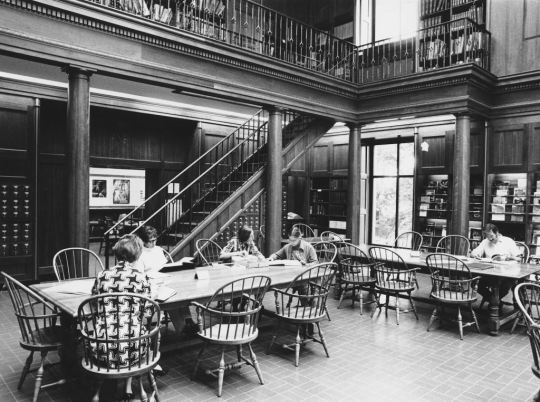
Frick Fine Arts Library, part of the ULS. University Library System The Hillman system of libraries included the general collection, as well as administrative control of the Bevier Engineering, Langley, Math, Music, Fine Arts, Economics, Physics, Chemistry, Computer Science, Allegheny Observatory and Social Work libraries. In 1979, the library acquired from the History Department the Archives of Industrial Society which, along with the University Archives, formed the Archives Service Center. The gathering of collections under one administrative umbrella was similar to the Falk Library of the Health Sciences, which combined the collections of the Schools of Medicine, Dentistry, and Pharmacy in 1957. In 1982, the University Library System formed in response to the recommendations of a task force that sought to improve efficiency within all the University libraries. The new ULS included the Hillman system, as well as the libraries of the Schools of Business, Library and Information Science, and Public and International Affairs. The ULS now includes the regional campus libraries and the Center for American Music, as well. By forming one cohesive system, Pitt’s libraries implemented new technologies en masse, including the University’s first online catalog and in 1996 the ULS’s first website. These libraries also utilize a unified technical services department to handle behind-the-scenes functions, such as cataloging and acquisitions.

The Digital Scholarship Commons, one of the many spacers where users can create, rather than consume, knowledge. Libraries of Today Today, the University’s libraries are in the midst of yet another evolution of services. The libraries, especially Hillman, have made the change from being collection-centric to user-centric spaces. More students use the physical library than ever before, and so group study rooms and technology enriched spaces compliment the more traditional reading and quiet study areas. The Cup & Chaucer café even provides food and drink to patrons, something that would have been inconceivable in the Cathedral’s library. To make room for more people, portions of the collection have been sent to high density storage at the Library Resource Facility; however, these materials remain highly accessible and can be requested electronically through PittCat. The libraries have also become a place where users can create knowledge rather than simply accessing it. Spaces like the Digital Scholarship Commons and one-button studio are available for users to create digital projects, videos, and other content. The ULS is also a leader in promoting open access and publishing scholarly, peer reviewed e-journals. The D-Scholarship institutional repository provides access to the research output of the University and, recently, librarians have played an active role in research data management. The beginning of Hillman Library’s renovation this summer marks the next exciting phase in the development of Pitt libraries.
- Zach Brodt
25 notes
·
View notes